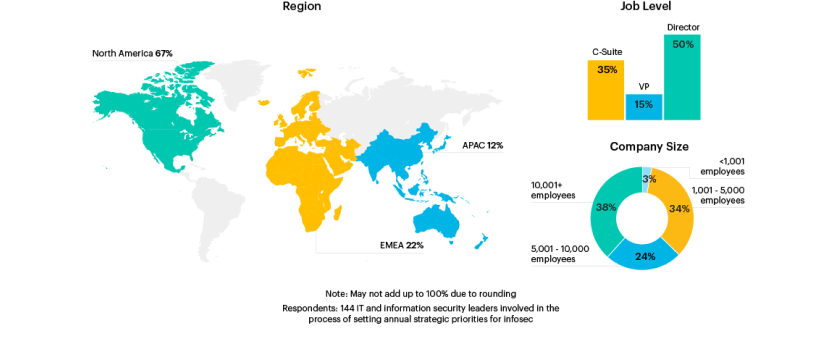Applications Of Generative AI In The Hiring Process
HR teams across organizations are utilizing generative AI (GenAI) to streamline their hiring process. From drafting job listings to screening resumes, GenAI’s applications have enhanced organizations’ recruitment strategies and shortened the time needed to close open positions. How are HR teams adapting GenAI to their personal needs, how successful have they been and what challenges are they facing?
One minute insights:
- Data security, cyber resilience and vulnerabilities are the most common strategic priorities for infosec in 2024
- Most respondents anticipate talent retention or talent shortages to be major hurdles to their infosec department’s 2024 priorities
- Many expect challenges due to the evolving landscapes of both cyberthreats and regulations
Data, resilience among top three infosec priorities for 2024
Nearly half (49%) of surveyed leaders indicate that data security is one of the top three priorities in their organization’s 2024 cybersecurity strategy.
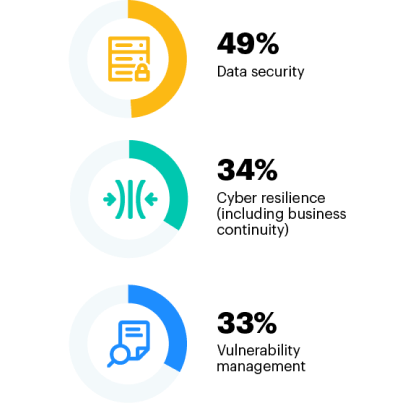
Based on your personal knowledge of your infosec department’s goals, what are most likely to be the top three priorities of its 2024 cybersecurity strategy? Select up to three.
Privacy program 27% | IAM 27% | New security tools 25% | Tools/vendor consolidation 24% | Cost efficiency 22% | Security awareness and training 20% | Incident response 19% | Regulatory compliance 17% | Risk management (including third-party risk) 15% | Technical debt reduction 13% | Training 10% | Hiring 6% | Not sure 1% | Other 0%
n = 144
Many foresee major challenges with both talent retention and hiring
The majority anticipate that skills gaps and training needs (55%) or retention (53%) could be key talent-related hurdles to achieving their 2024 strategic priorities for infosec.

Which talent-related issues, if any, do you think could pose the biggest challenge(s) to achieving your infosec department’s top three strategic priorities for 2024? Select all that apply.
Succession planning and/or leadership development 26% | Team morale 14% | Diversity and inclusion 13% | Employee engagement 13% | Adjustment to in-office working requirements 8% | None — I don’t foresee any talent-related challenges 3% | Not sure 0% | Other 0%
n = 144
Most expect budget limitations and regulations to be key hurdles in 2024
54% of surveyed leaders expect the evolving threat landscape to be one of the biggest challenges to their 2024 infosec priorities. Over half (52%) list budget restrictions among their biggest obstacles.
Apart from talent-related issues, which of the following do you think could pose the biggest challenge(s) to achieving your infosec department’s top three strategic priorities for 2024? Select all that apply.

Organizational resistance to change 25% | Enterprise risk appetite (e.g., increased or unclear appetite) 21% | Prioritization issues 21% | Technical debt 21% | Geopolitical uncertainty 20% | Lack of executive support 20% | Misalignment with business strategy 13% | Strategic plan is too ambitious 8% | Strategic plan lacks flexibility 6% | Not sure 1% | Other* 1% *Other includes: Post-acquisition chaos
n = 144
Question: Please share any final thoughts or personal opinions about your infosec department’s strategic priorities and planning for 2024.
Dealing with an impending acquisition, I have no doubts that 2024 will be extremely challenging for those employees who managed to stay with the company. Adopting the new company’s priorities will take some time.
Over two-thirds of HR professionals report they have received an application or resume with AI-generated copy, and most are using applicant tracking software to identify GenAI content
To your knowledge, have any resumes/applications received by your organization contained copy generated by AI tools?
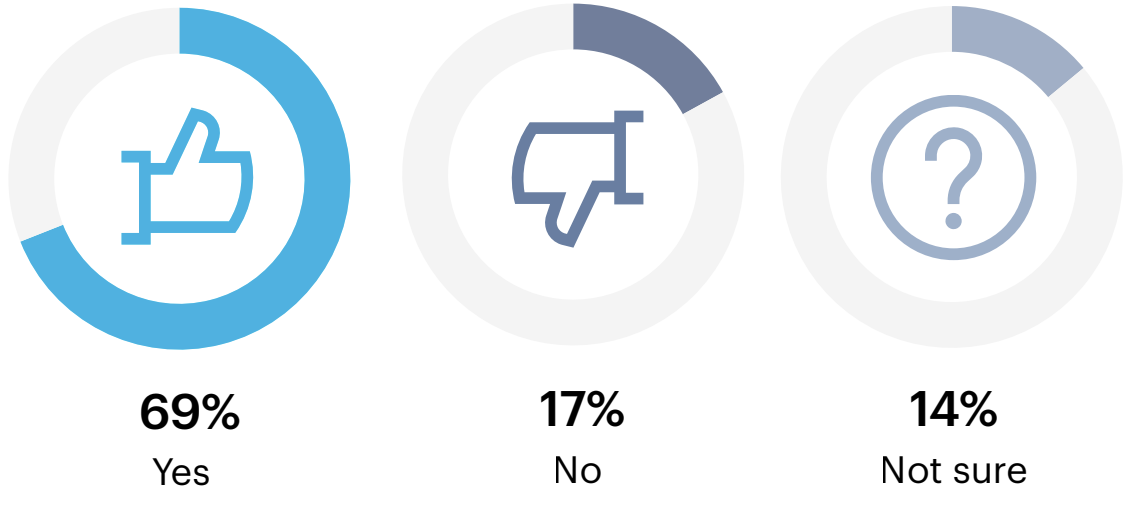
69% of respondents report their organization has received a resume/application that contained copy generated by AI tools.
n = 64
Note: May not add up to 100% due to rounding
Over half of HR professionals (57%) who report their organization has received an application/resume with AI-generated copy (n=44), say 25-50% of applications/resumes they receive today contain GenAI produced content.
To your knowledge, what percentage of resumes/applications received by your organization today contain AI-generated copy?
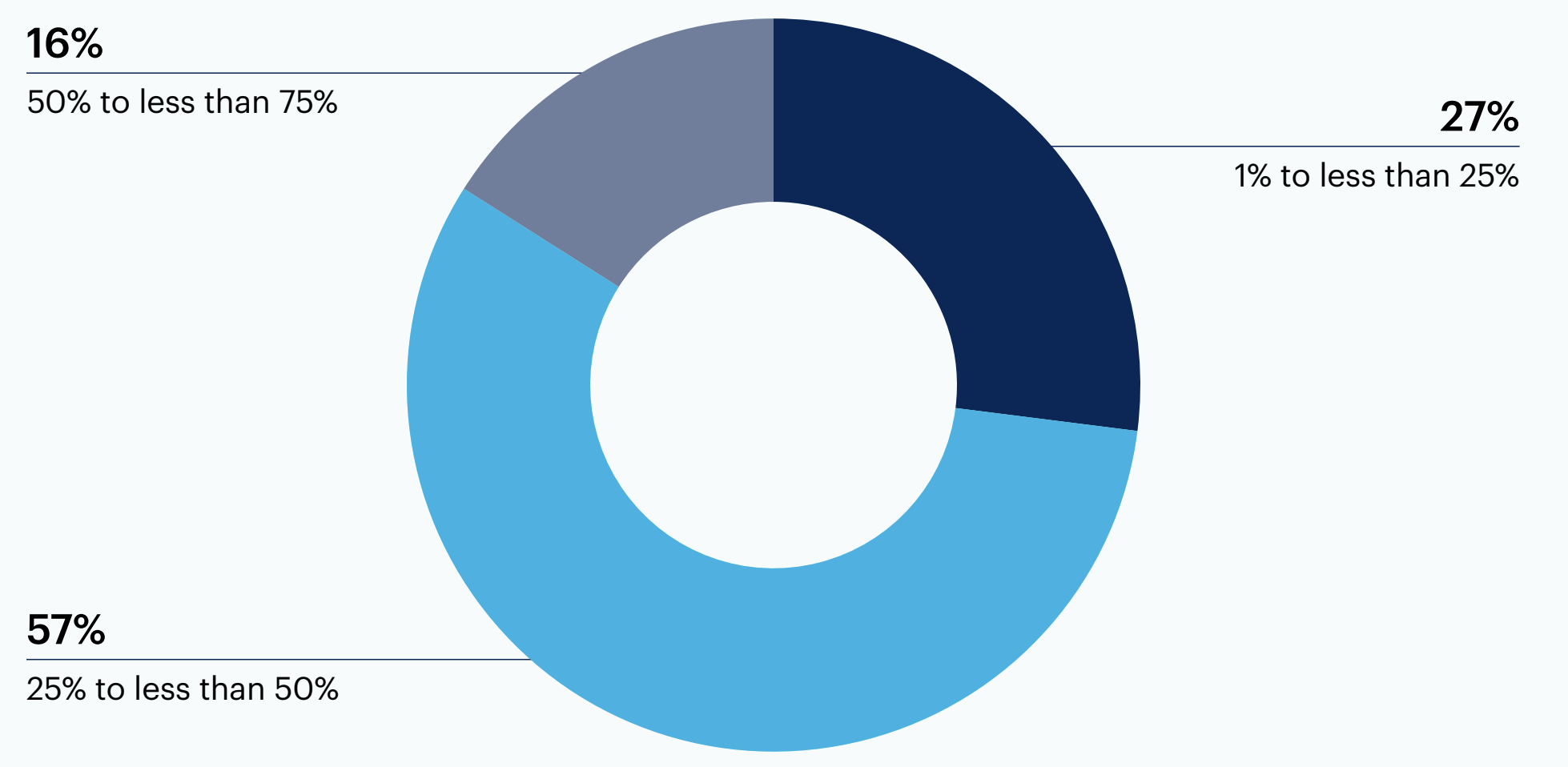
75% to less than 100% 0% | 100% 0% | Not sure 0%
Note: May not add up to 100% due to rounding
Question shown only to respondents who answered “Yes” to the question, “To your knowledge, have any resumes/applications received by your organization contained copy generated by AI tools?”
69% of respondents report their organization uses applicant tracking software to identify resumes/applications that contain AI generated copy. Manual review by the HR team (61%), is another top selected tool.
What tools, if any, is your organization using to identify resumes/applications containing AI generated copy? Select all that apply.
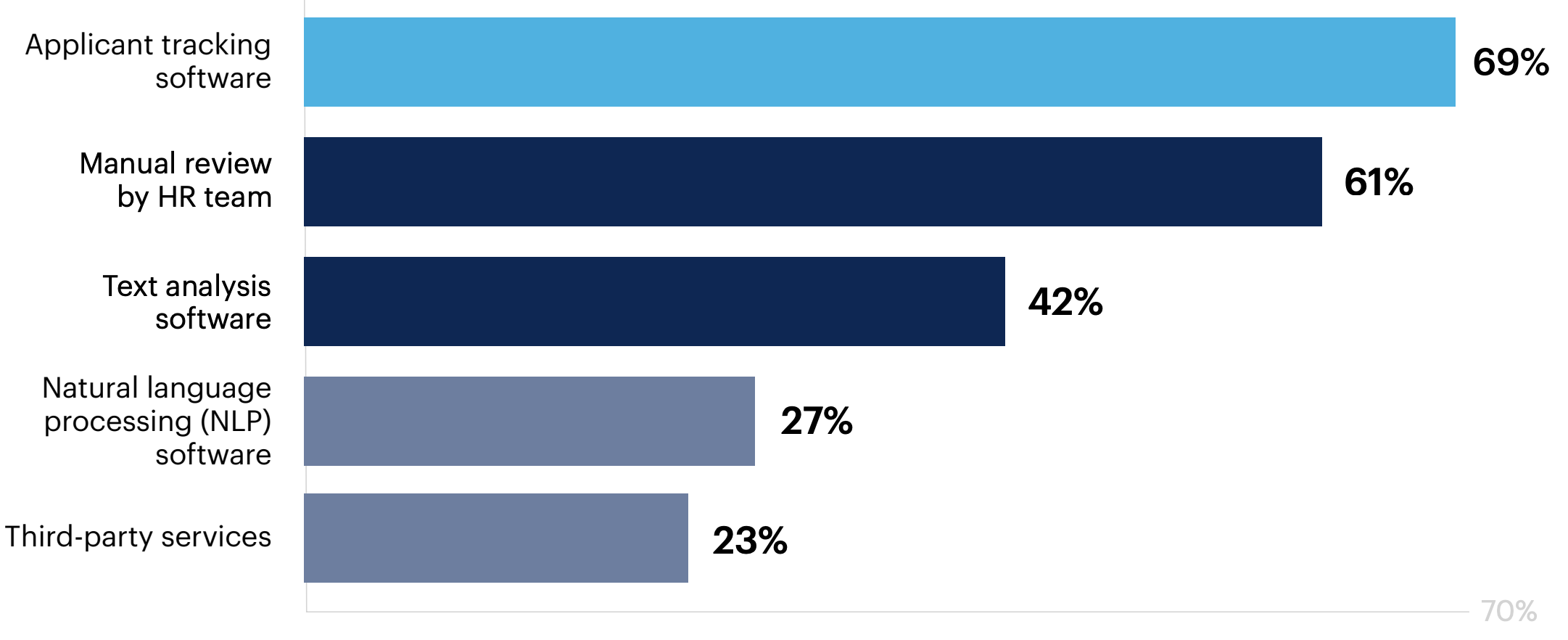
AI or ML algorithms 21% | We don’t use any tools for this 6%
n = 64
41% of HR professionals say their organization has a separate evaluation process for AI-generated resumes/applications. 14% say their organization hasn’t established a process to handle these documents yet.
How does your organization primarily address resumes/applications containing AI-generated copy?
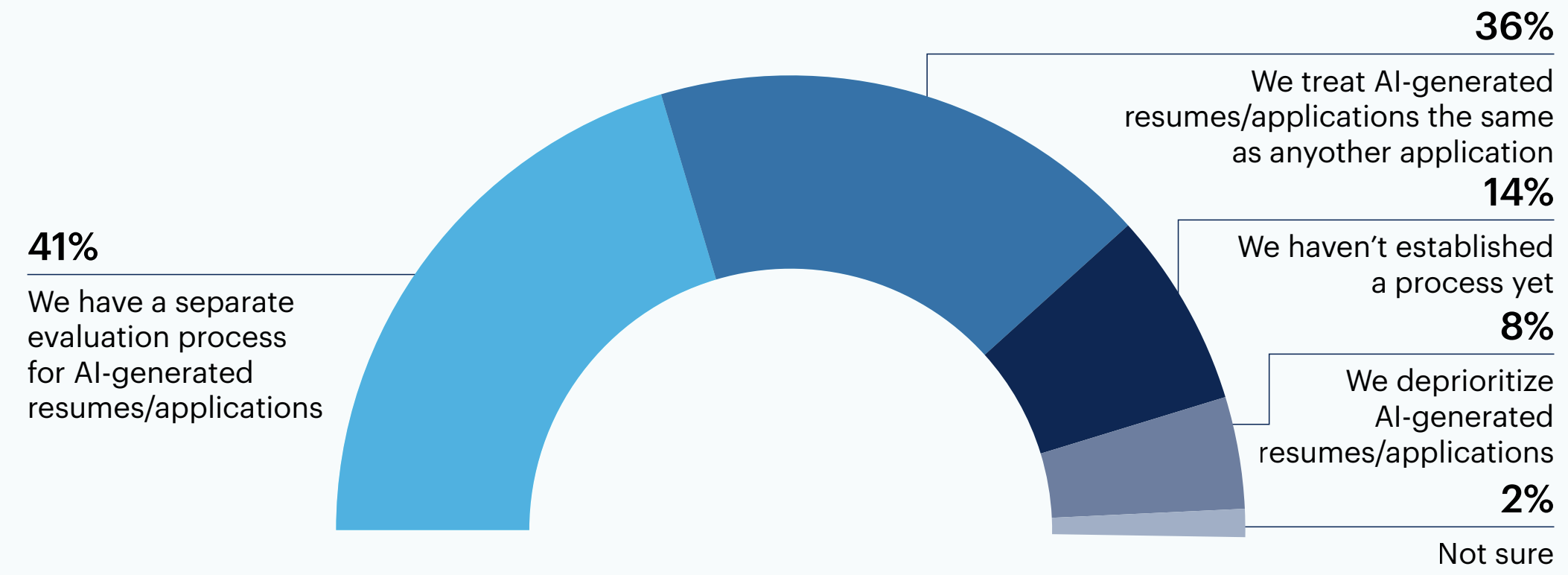
n = 64
We discard AI-generated resumes/applications 0%
Note: May not add up to 100% due to rounding
Question: As an HR leader, how do you personally feel about applications/resumes submitted containing AI-generated copy? How should organizations today be addressing them?
We have a strong process of evaluating candidates through assessments, so I dont think AI generated resumes would be an issue. We use technical and behavioral assessments for evaluating candidates so even if the resume copy is AI generated, and the candidate is lacking skills, we would be able to capture the feedback with the checks and balances in place.
I don't agree with AI generated applications because we can't really be sure that the information given is true, even if the applicant is not lying, we don't know the extent in which they used AI for their application or resume.
I feel indifferent, on one side candidates can leverage AI tools to empower themselves in the job hiring process, on the other hand the AI tool can get it completely wrong.
I have mixed feelings as the use of AI reduced the need for authentic expression, yet the candidate who uses AI demonstrates tech literacy.
The majority of HR professionals report the benefits of GenAI in the hiring process outweigh the risks, and most report their organization will be increasing investments over the next 12 months
22% of respondents report investments in GenAI for their hiring process will significantly increase at their organization over the next 12 months. An additional 47% say investments will somewhat increase, while just 5% report their organization will decrease investments.
Over the next 12 months, how does your organization plan to invest in generative AI technologies for the hiring process?
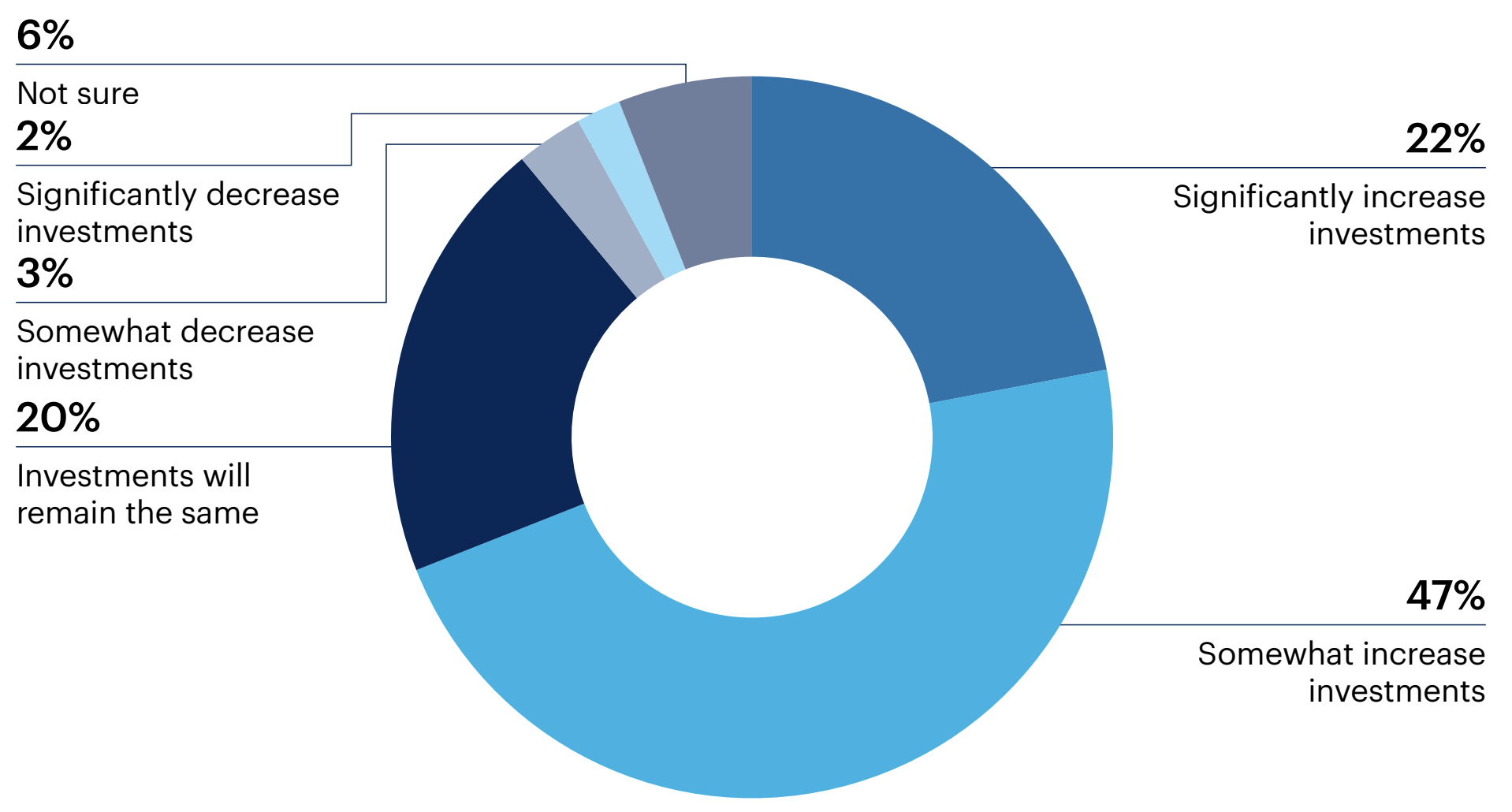
n = 64
Note: May not add up to 100% due to rounding
The top selected challenge respondents anticipate their organization will face from using GenAI in the hiring process is the risk of overlooking candidates (56%). Authenticity of applicant information (52%), and diff iculty identifying AI-generated resumes/applications (50%) are also selected by at least half of respondents.
What challenges does your organization anticipate from the use of generative AI in the hiring process? Select all that apply
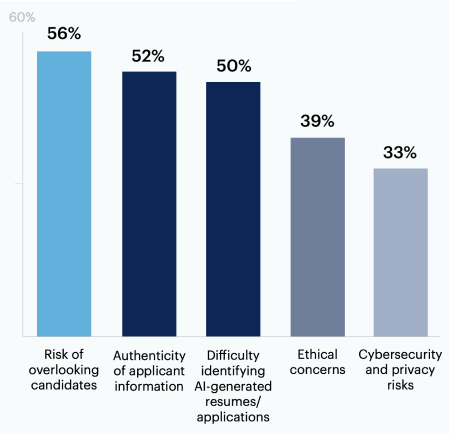
Legal complexities 31% | Over-reliance on AI leading to labor disruptions 23% | We don’t anticipate any challenges 2%
n = 64
Question shown only to respondents who answered “Yes” to the question, “Does your organization currently use generative AI in any part of your hiring process?”

41% of HR professionals report their organization plans to offer training to their recruiters on identifying AI-generated resumes/applications over the next 12 months. 34% report their organization already offers this.
Over the next 12 months, does your organization plan to offer training to recruiters/HR employees on identifying AI-generated resumes/applications?
n = 64
Note: May not add up to 100% due to rounding
74% of respondents somewhat or strongly agree that the benefits of generative AI in the hiring process outweigh the risks. Just 3% disagree.
How do you feel about the following statement: “The benefits of generative AI in the hiring process outweigh the risks.”
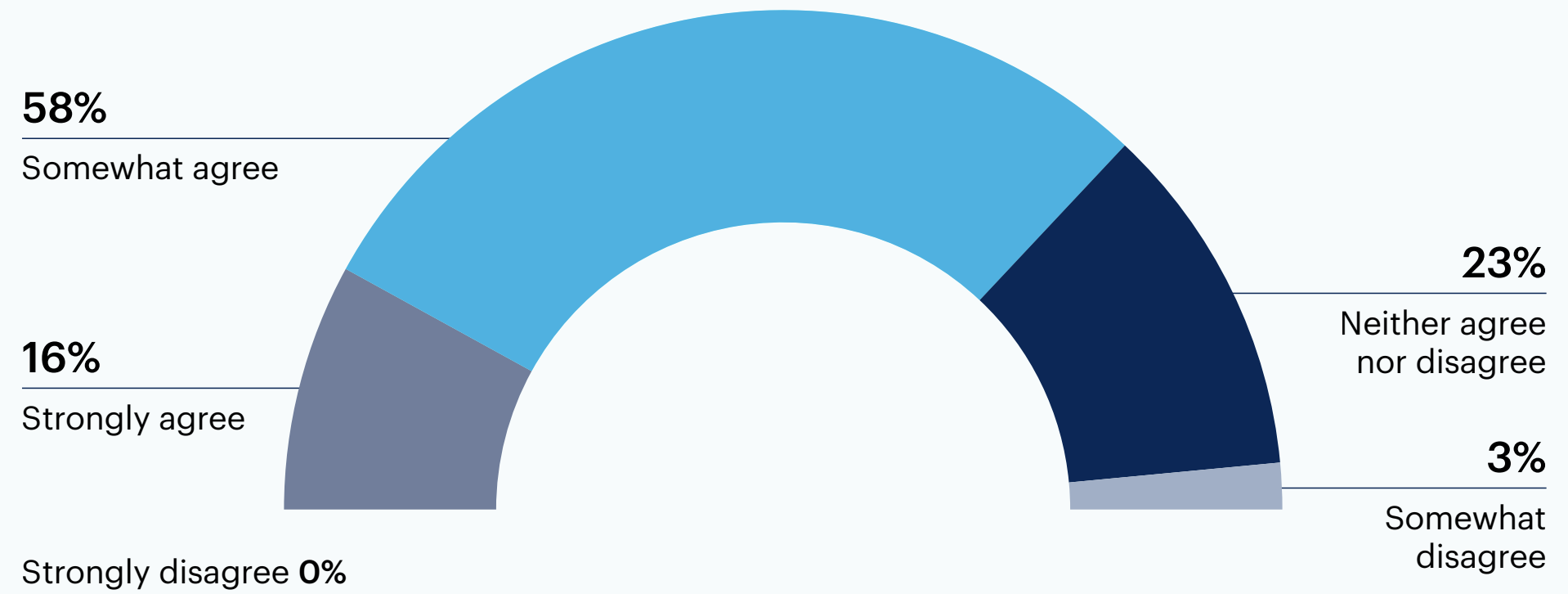
n = 64
Note: May not add up to 100% due to rounding
Question: Any final thoughts to share about how you anticipate generative AI will impact the hiring landscape over the next 12 months, and how organizations should prepare?
We have to proceed with caution and remain in compliance in order to be mindful of the errors that can occur using generative AI. If used properly, it can help make the hiring process more fluid. While there are advantages to be had, it is still a young technology and should be reviewed as such..

Want more insights like this from leaders like yourself?
Click here to explore the revamped, retooled and reimagined Gartner Peer Community. You'll get access to synthesized insights and engaging discussions from a community of your peers.
Respondent Breakdown
